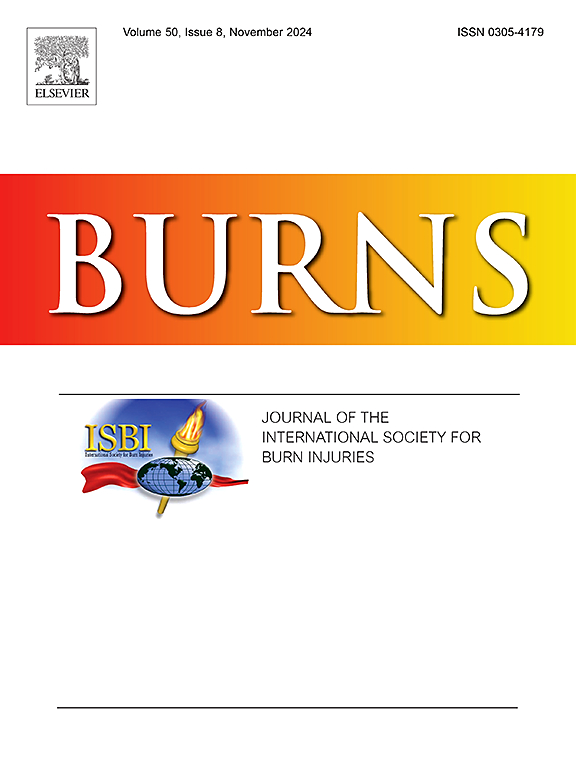ChatGPT as a collaborative research assistant in the ICF linking process of the brief version of the Burn Specific Health Scale
IF 2.9
3区 医学
Q2 CRITICAL CARE MEDICINE
引用次数: 0
Abstract
Introduction
Burn injuries profoundly affect multiple aspects of health-related quality of life (HRQoL). The Brief Version of the Burn Specific Health Scale (BSHS-B) is commonly used to assess HRQoL in burn survivors. Linking such tools to the International Classification of Functioning, Disability and Health (ICF) enhances data comparability and standardisation for patients with burn injuries. However, linking process is often complex and time-consuming. Large language models may support linking process and help streamline future linking studies in burn rehabilitation.
Objectives
This study evaluated the feasibility of using ChatGPT-4o as a collaborative assistant in the ICF linking process of BSHS-B items.
Methods
The study followed the refined ICF linking rules. In the first stage, two physiotherapists independently linked the contents of BSHS-B items to ICF categories. When the two linkers disagreed, a third assigned the item to a category. In the second stage, ChatGPT-4o guided by specialised prompting performed the same task according to linking rules. In the content analysis, Cohen’s Kappa coefficient was computed to evaluate the consistency between expert consensus and ChatGPT-4o-based linking. An agreement on item perspective analyses was also conducted. Frequencies of identified ICF categories across major domains were reported descriptively.
Results
The agreement between linkers on ICF category assignment was fair (κ = 0.41, p < .001), while ChatGPT and expert consensus agreement was moderate (κ = 0.55, p < .001). In the perspective analysis, agreement between experts was fair (κ = 0.21, p < .01), whereas ChatGPT demonstrated almost perfect agreement with experts (κ = 0.86, p < .001). A total of 25 ICF codes were identified, mainly in Activity Participation (52.11 %) and Body Functions (40.85 %).
Conclusion
ChatGPT demonstrated substantial potential in the ICF linking process as a supportive tool. While not replacing human expertise, ChatGPT may be able to reduce workload and facilitate ICF linking process.
ChatGPT作为《烧伤特定健康量表简编》ICF链接过程的合作研究助理
烧伤严重影响健康相关生活质量(HRQoL)的多个方面。简要版烧伤特定健康量表(BSHS-B)通常用于评估烧伤幸存者的HRQoL。将这些工具与国际功能、残疾和健康分类(ICF)联系起来,增强了烧伤患者数据的可比性和标准化。然而,链接过程往往是复杂和耗时的。大型语言模型可能支持连接过程,并有助于简化未来烧伤康复的连接研究。目的评价chatgpt - 40在BSHS-B项目ICF连接过程中作为协同辅助工具的可行性。方法采用改进的ICF连接规则。在第一阶段,两名物理治疗师独立地将BSHS-B项目的内容与ICF类别联系起来。当两个链接器不同意时,第三个链接器将项目分配到一个类别。在第二阶段,chatgpt - 40在特殊提示的引导下,根据链接规则执行相同的任务。在内容分析中,计算Cohen 's Kappa系数来评估专家共识与基于chatgpt -4的链接之间的一致性。还就项目透视分析达成了一致意见。描述性地报告了主要领域中已确定的ICF类别的频率。结果链接者对ICF分类分配的一致性为一般(κ = 0.41, p <; .001),而ChatGPT与专家共识的一致性为中等(κ = 0.55, p <; .001)。在透视分析中,专家之间的一致性是一般的(κ = 0.21, p <; .01),而ChatGPT表现出与专家几乎完全一致(κ = 0.86, p <; .001)。共鉴定出25个ICF编码,主要为活动参与(52.11 %)和身体功能(40.85 %)。结论chatgpt在ICF连接过程中作为一种支持工具显示出巨大的潜力。虽然ChatGPT不能取代人类的专业知识,但它可以减少工作量并促进ICF链接过程。
本文章由计算机程序翻译,如有差异,请以英文原文为准。
求助全文
约1分钟内获得全文
求助全文
来源期刊

Burns
医学-皮肤病学
CiteScore
4.50
自引率
18.50%
发文量
304
审稿时长
72 days
期刊介绍:
Burns aims to foster the exchange of information among all engaged in preventing and treating the effects of burns. The journal focuses on clinical, scientific and social aspects of these injuries and covers the prevention of the injury, the epidemiology of such injuries and all aspects of treatment including development of new techniques and technologies and verification of existing ones. Regular features include clinical and scientific papers, state of the art reviews and descriptions of burn-care in practice.
Topics covered by Burns include: the effects of smoke on man and animals, their tissues and cells; the responses to and treatment of patients and animals with chemical injuries to the skin; the biological and clinical effects of cold injuries; surgical techniques which are, or may be relevant to the treatment of burned patients during the acute or reconstructive phase following injury; well controlled laboratory studies of the effectiveness of anti-microbial agents on infection and new materials on scarring and healing; inflammatory responses to injury, effectiveness of related agents and other compounds used to modify the physiological and cellular responses to the injury; experimental studies of burns and the outcome of burn wound healing; regenerative medicine concerning the skin.
 求助内容:
求助内容: 应助结果提醒方式:
应助结果提醒方式:


